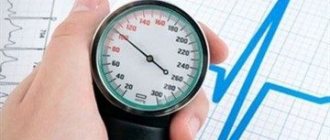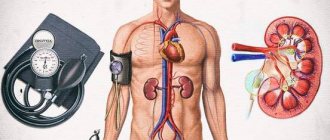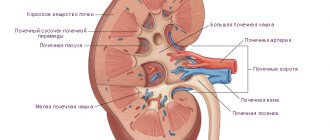Hypertensive form of pyelonephritis
The hypertensive form of pyelonephritis is the most common type of symptomatic hypertension caused by a disease of the renal structure. Hypertension does not appear in the initial stages of the disease, but occurs as nephrosclerosis develops. The more advanced the stage of pyelonephritis, the higher the rates of arterial hypertension. This is due to the fact that sclerosis of the renal tissue disrupts the exchange of sodium and potassium in the human body.
The kidneys are directly involved in the regulation of blood pressure
Diagnostics
The diagnosis is established based on the patient’s complaints and laboratory test results, such as:
- urine and blood tests to determine the inflammatory process;
- ultrasound examination of the kidneys;
- renography;
- MRI.
Ultrasound shows altered kidney size and presence of edema
If the diagnosis confirms kidney dysfunction, a referral is issued for a blood test, during which the content of the renin element is determined. Its increase indicates the renal nature of hypertension. The chronic form of pyelonephritis is also characterized by a high level of leukocytes in the urine.
In some cases, a kidney biopsy may be recommended.
Symptoms
- Pallor.
- Negative diuresis occurs when the amount of fluid consumed is greater than the amount of fluid excreted.
- Increased number of heartbeats. Tachycardia develops against the background of the fact that the vessels are constantly narrowed due to the large amount of fluid in them, the heart begins to beat more often, but with less force.
- High blood pressure, which increases significantly in the morning. This is due to the fact that at night a person goes to the toilet a little and the liquid drunk during the day accumulates in the body, the kidneys at this time are not able to filter it efficiently due to the fact that pyelonephritis develops in them. This entails increased morning blood pressure.
- Frequent urination in small portions of urine.
- Constantly cold and damp palms and feet. The palms and feet become cold due to the fact that the peripheral vessels are too narrowed and blood is simply not able to penetrate into them, and they become wet due to the fact that excess fluid tries to be eliminated through the pores.
Renal hypertension is particularly characterized by an increase in lower (diastolic) blood pressure
Classification of the disease
There are two forms of nephrogenic hypertension:
- Vasorenal, or renovascular, - 30% of cases;
- parenchymal, or nephrosclerotic/renoparenchymal - 70% of clinical studies.
Vasorenal nephrogenic hypertension
Appears against the background of a violation of the integrity of blood vessels: atherosclerosis, thromboembolism, due to which the renal arteries narrow and the kidneys do not receive enough blood. It usually manifests itself as severe lumbar pain and increased pressure in the arteries of the kidneys.
Treatment involves only urgent surgery. According to the results of observations of specialists, pathology is established in 5% of patients with hypertension, in a third of them the disease is malignant, dynamically developing, accompanied by complications.
Parenchymal nephrogenic hypertension
The cause of this pathology is diffuse changes in the intrarenal vessels, nephrons and glomeruli: nephritis, initial glomerulonephritis, chronic pyelonephritis, more often at a young age, as well as nephropathy due to diabetes, vasculitis. As a result, the kidneys do not receive the required amount of blood.
Symptoms are expressed in:
- increased lower (renal) pressure, plasma in the blood;
- swelling due to water retention in the body, which leads to excess sodium (overhydration, hematuria);
- hormonal imbalances that inhibit the depressor function of the kidneys.
At the first stage of the disease, treatment can be carried out with medications: antihypertensive drugs and drugs to normalize kidney function. In advanced, severe forms, as well as in unilateral shrinkage of the kidney - chronic pyelonephritis - only an operation called nephrectomy is indicated. Late adoption of this measure is fraught with irreversible consequences:
- arteriosclerotic nephrosclerosis of the second, healthy kidney;
- uncompensated hypertension;
- further progression of pathologies even after removal of the affected kidney.
The reasons causing the above-described disorder may lie in both congenital and acquired kidney pathologies, sometimes in disturbances of regional circulation, the renin-angiotensive hormonal system (RAS), which is responsible for the level of pressure and blood volume. It is curious that in 43% of patients arterial hypertension is caused by bilateral chronic pyelonephritis than unilateral (35%).
So, let's summarize:
- hypertension of nephrogenic origin is preceded by inflammatory reactions of the kidneys, the first two weeks or several hours/days occur in latent or mild forms, but then the duration and severity of symptoms gradually increase;
- combination therapy helps only at the very beginning of the disease;
- in case of persistent, uncontrollable high blood pressure, nephrectomy should be resorted to.
It is also worth noting that the nephropathic form of hypertension during pregnancy occurs in the case of kidney intoxication due to the influence of the placenta on the female body or endocrine imbalance. It is determined by swelling, a stable increase in blood pressure and the number of plasma proteins in the glomerular capillaries of the kidneys.
Diagnostic measures
In case of increased blood pressure, it is necessary to clarify the cause-and-effect relationship between pyelonephritis and hypertension. To do this, the nephrologist must collect a detailed history and find out about the presence of other diseases of the genitourinary system. It will also be necessary to conduct laboratory tests of urine and perform a full diagnosis of the body in order to exclude other causes of increased blood pressure, namely cardiovascular diseases and pathologies of the nervous system.
This is very important because symptomatic hypertension due to pyelonephritis has a treatment that is quite different from that for other forms of hypertension. As you know, high blood pressure that is not treated can lead to serious complications such as stroke and heart attack.
Kidney ultrasound is a mandatory diagnostic method when detecting high blood pressure in a patient
Laboratory research
In acute pyelonephritis, a general urine test can show proteinuria (protein in urine) and hematuria (blood in urine). After acute pyelonephritis goes into remission, the clinical picture of a general urinalysis may be pathologically unchanged. Also, in case of pyelonephritis, bacteriological culture of urine for flora is performed, in which in 99 percent of cases bacterial colonies grow.
Ultrasonography
Often, with pyelonephritis, one or two kidneys are pathologically changed. The renal pelvis is enlarged and thickened. Also, ultrasound examination can show foci of infection during an exacerbation of pyelonephritis.
Every patient with chronic kidney disease should regularly monitor their blood pressure
Relationship between blood pressure and pyelonephritis
The secondary form of hypertension most often develops due to kidney disease.
Enter your pressure
Move the sliders
120
on
80
Blood pressure level is associated not only with the condition of the cardiovascular system, but also with the condition of the kidneys. For the normal functioning of the paired organ, a certain blood pressure is required, which the kidneys provide for themselves by producing the substance renin. If a person is healthy, then renin regulates blood pressure and all systems work fully. If blood flow to the kidneys decreases, the amount of renin produced increases. When this substance interacts with hormones that have a vasoconstrictor effect, blood circulation is disrupted, which negatively affects blood pressure levels and hypertension occurs.
Kidney disease can cause damage to blood vessels.
On the other hand, an increase in blood pressure is observed in kidney pathologies, during which their structure changes and, accordingly, their function deteriorates. Typically, this picture is observed with glomerulonephritis or if the patient has chronic pyelonephritis. The disease provokes degeneration of the renal parenchyma, damage to blood vessels and insufficient synthesis of substances that lower blood pressure. Therefore, hypertension develops with pyelonephritis.
Treatment
If high blood pressure was caused by pathological changes in the kidneys, treatment consists of curing the underlying disease. This is due to the fact that in this case arterial hypertension is symptomatic, that is, it is caused by renal pathology. Therefore, if this pathology is cured, the pressure will decrease by itself. But until pyelonephritis goes into remission, medications will be prescribed to lower blood pressure. Treatment of symptomatic arterial hypertension should be carried out in any case, because, as mentioned above, hypertension can cause severe complications, including death. A neurologist and therapist, after conducting a joint examination of your body, will individually select medications for you that can effectively reduce blood pressure.
It is also worth remembering that medications that lower blood pressure are taken daily at least once a day. It is unacceptable to skip medications.
Treatment of pyelonephritis is a long, painstaking work, but it is worth remembering that the earlier therapy is started, the greater the chance that the disease will not become chronic. In the initial stages, treatment includes antibacterial therapy and symptomatic medications to reduce fever, pain and urinary dysfunction. After eliminating the acute period, specialists prescribe maintenance therapy for one year and sanatorium treatment.
What will happen if left untreated?
Lack of treatment usually leads to the transformation of pyelonephritis, as well as other renal infectious diseases, into chronic, sometimes purulent forms: paranephritis and subsequent bacteriotoxic shock. The following consequences are possible:
- persistent arterial hypertension;
- heart, kidney failure;
- increased intraocular pressure, which leads to complete or partial loss of vision - hypertensive retinopathy;
- heart attacks, strokes, disorders of the brain, lipid metabolism;
- changes in blood composition;
- low elasticity of the walls of blood vessels.
Development mechanism, risk factors
When the renal vessels are damaged, the parenchymal tissues feel a lack of oxygen. In response to this, the organ begins to intensively produce the hormone renin, which causes spasm and constriction of small blood vessels. Blood pressure increases, mainly diastolic.
In other cases, the development of kidney diseases with damage to the glomerular filter causes the production of renin. In this case, the process of filtration and reabsorption of blood is disrupted; an excess amount of liquid and sodium remains in the vessels, which accumulates in the walls of the vessels. Calcium also accumulates there.
ATTENTION!
Many of our readers actively use the well-known method based on natural ingredients, discovered by Elena Malysheva, to treat and restore KIDNEYS. We recommend that you check it out.
- How to treat bilateral chronic pyelonephritis
Sodium increases the sensitivity of vascular walls to the effects of hormones, calcium promotes vasoconstriction - peripheral resistance increases, blood pressure levels rise sharply.
- cardiovascular diseases;
- diabetic nephropathy, damaging glomerular filters;
- diseases of the thyroid gland with excess thyroid hormones;
- age, older people get sick more often - their vessels are more susceptible to atherosclerosis;
- gender, more cases of the disease in men;
- excess weight and cholesterolemia provoke vascular sclerosis;
- excessive consumption of salt, smoked meats and marinades cause vascular spasms;
- nervous tension and prolonged stress disrupt the functioning of the heart, blood vessels, kidneys and other organs;
- predisposition to the disease;
- apnea and intermittent breathing during sleep limit the supply of oxygen to the blood;
- bad habits, low standard of living, and poor nutrition worsen the functioning of the cardiovascular system.
High blood pressure can cause adrenal tumors. With aldosteroma, the hormone aldosterone is actively produced, with pheochromocytoma - adrenaline. They cause an increase in blood pressure. In the second case, it rises sharply, significantly, tachycardia, sweating, hot flashes, and skin hyperemia are noticeable.
Thyroid hormones produced in diseases of the thyroid gland cause tachycardia, which increases blood pressure.
Causes of hypertension in pyelonephritis
Pyelonephritis is a disease in which inflammation of the kidneys occurs. More often, women suffer from pathology after suffering from cystitis. Men get sick in old age, the cause is stones in the bladder or prostatitis. It happens that the disease takes on a malignant course: it develops quickly and significantly increases blood pressure.
Arterial hypertension with pyelonephritis occurs in 40% of cases.
It is important to begin treatment of the disease in a timely manner and prevent the development of complications, otherwise the organ will cease to perform its functions in full and the disease will enter the chronic stage.
Classification of renal forms of hypertension
Any kidney pathology is accompanied by an increase in blood pressure - this condition is called nephrogenic arterial hypertension. Most often it occurs due to inflammation, but can also develop due to urolithiasis of the kidneys, glomerulonephritis, cysts, tumors and other pathologies.
There are two types of nephrogenic hypertension:
- Vasorenal hypertension occurs in 30% of patients due to narrowing of the renal arteries. The pathogenesis of vascular stenosis is based on atherosclerosis. Through spasmodic arteries, blood flows poorly to the kidneys and ischemia begins. In response, the kidneys secrete renin, which normally should maintain vascular tone. But too much of it enters the blood, and the hormone accumulates sodium and increases the volume of circulating fluid. All this leads to an increase in blood pressure numbers.
- Parenchymal hypertension is observed in 70% of cases among all kidney diseases and is often a consequence of chronic pyelonephritis. With it, the vessels of the organ, due to diffuse changes, are not able to accommodate the required volume of blood, the renal glomeruli and intrarenal vessels suffer. Fluid accumulates in the body, resulting in sodium retention. All of the above leads to increased blood pressure (BP).
Link between kidney disease and high blood pressure
Many people believe that only the heart is responsible for blood pressure numbers in the body. But that's not true. The kidneys also play an important role in its maintenance. Pyelonephritis and blood pressure are closely related. There are 2 reasons why blood pressure increases due to the kidneys.
In order for the kidneys to work properly and perform their functions, a certain pressure must be present in them. To maintain it, the paired organ secretes the hormone renin.
But in case of illness, when for some reason the kidneys begin to suffer (vasoconstriction, ischemia), renin is released in large quantities. It binds to other hormones and together with them inhibits the removal of sodium and water from the body.
The volume of circulating blood increases and the pressure increases.
The second reason is when the structure of an organ is disrupted due to disease: the kidney tissue becomes thinner and the blood vessels are affected. This leads to a decrease in the production of depressant substances, which can lower blood pressure.
Main symptoms
The signs of nephrogenic hypertension are similar to hypertension.
The most common manifestations include:
- cephalgia,
- nausea and vomiting
- increase in body temperature,
- pain in the lumbar region,
- the appearance of swelling under the eyes.
A person also notices a dysfunction of the bladder:
- frequent urge to urinate;
- pain and burning when emptying the bladder;
- unpleasant odor of urine;
- impurities in the urine (blood, pus, cloudy sediment).
Often there are no signs of kidney disease at all, and pathology is discovered only during examination of the patient.
Chronic pyelonephritis may not manifest itself for a long time. Only a thorough history taking and other research methods will help make a diagnosis. In the chronic course of the disease, patients note:
- periodic increase in body temperature within 37.1-38.0 °C;
- aching pain in the lumbar region;
- urination disorders: frequent night urges, difficult or painful urination;
- hyposthenuria is a symptom that appears in the early stages of chronic pyelonephritis and means a decrease in urine density.
Chronic pyelonephritis has 5 forms of development.
Latent, or hidden, characterized by a sluggish course. Occasionally a person is bothered by general malaise, increased body temperature, and headache. There are no manifestations from the kidneys.
When examining urine, you can detect an increased amount of protein, leukocytes and bacteria, and a decrease in density. Blood tests show anemia. Blood pressure is normal or slightly elevated.
In cases where latent pyelonephritis has not been detected for a long time, the patient develops chronic renal failure. This form of the disease is called azotemic.
In the hypertensive form, the main symptom is high blood pressure. Patients complain of headache, nausea, insomnia, pain in the heart, and shortness of breath.
The recurrent form occurs with periods of exacerbation and remission. Clinical manifestations at the height of the disease are similar to acute inflammation. The patient complains of chills, pain in the lumbar region, difficulty urinating, increased body temperature, weakness, general malaise, and insomnia. High blood pressure, up to hypertensive crisis. During remission, all symptoms disappear.
The anemic form occurs with frequent dizziness, weakness, shortness of breath, and heart pain. These patients have pale skin. The results of urine tests are not informative, since changes are periodic. The pressure does not increase with this form.
Treatment
Before starting therapy, a correct diagnosis must be established. To do this, the patient must pass a series of tests and undergo instrumental examination methods.
The patient is prescribed general urine and blood tests, as well as biochemistry. Based on the results, you can understand whether there is inflammation in the body and how the kidneys work. Then the patient needs to undergo a kidney ultrasound or x-ray.
With the help of these studies, it will be possible to find out the condition of the organ and its vessels.
A person with pyelonephritis and blood pressure needs to completely change their lifestyle. To do this, he should:
- give up cigarettes and alcohol;
- reduce weight;
- eat right (salt up to 5 grams per day, limiting animal fats, reducing the amount of fluid consumed);
- increase physical activity.
Treatment of acute pyelonephritis includes the use of several groups of drugs. The doctor’s task is to influence the etiological factor and provide symptomatic assistance. First of all, the doctor needs to stop the inflammatory process in the organ.
For this purpose, the patient is prescribed broad-spectrum antibiotics. For example, cephalosporins, macrolides, fluoroquinolones, tetracyclines. The next step is to lower blood pressure. Among antihypertensive drugs there are those that have a nephroprotective effect.
These include:
- ACE inhibitors (Captopril, Lisinopril);
- calcium channel blockers (Verapamil, Nifedipine);
- angiotensin receptor blockers (Candesartan, Losartan).
Each patient is assigned his own treatment regimen. It depends on several factors:
- age,
- the presence of complications from the cardiovascular system,
- blood pressure numbers.
It must be remembered that a sharp decrease in blood pressure is life-threatening. Therefore, the doctor independently selects the drug and dosage for each patient. Often a patient needs several antihypertensive drugs at once.
Diuretic tablets will also be prescribed to remove excess fluid from the body.
Surgical treatment is indicated in cases where chronic inflammation has progressed to shrinkage of the kidney, but provided that the second organ is healthy and can perform its functions in full. If both kidneys have shriveled, it is possible to remove the organ and replace it with a donor one.
Prevention
There are primary and secondary prevention. The primary is aimed at preventing acute inflammation, and the secondary at the occurrence of relapse.
- Timely treatment of diseases of the genitourinary system: cystitis, urethritis, urolithiasis, cysts, kinks of the ureters.
- Boosting immunity.
- Sanitation of chronic foci of infection (tonsillitis, sinusitis, colitis and others).
Pyelonephritis is a serious disease that can provoke the development of a number of dangerous complications. To avoid dire consequences, you need to monitor your condition and consult a doctor if signs of pathology appear.
(4 5,00 of 5) Loading...
Source: https://SosudInfo.com/hypertension/gipertenziya-i-pielonefrit.html
Causes of nephrogenic arterial hypertension
High blood pressure can be caused by exposure to the following factors or pathological conditions on the human body:
Stones in the urinary organs can provoke an increase in blood pressure.
- chronic pyelonephritis;
- glomerulonephritis;
- coarctation of the aorta;
- thickening of arterial walls;
- the presence of kidney stones;
- renal artery dissection;
- atherosclerosis;
- blockage of blood vessels;
- improper diet;
- sedentary lifestyle;
- smoking;
- stress;
- contact with toxins;
- hereditary predisposition.
Most often, arterial hypertension occurs with glomerulonephritis.
Return to contents
Complications
If the disease is left untreated for a long time, serious complications can occur.
Bacteriological shock has a rapid development rate. Pus accumulates in the tissues, which is toxic to the body. In 65% of cases, without treatment, the person dies. Therapy is carried out in the intensive care unit.
Arterial hypertension is a reversible complication of the disease. With properly selected therapy, blood pressure normalizes.
Without timely treatment of high blood pressure, there is a risk of developing hypertensive retinopathy - damage to the retinal vessels. The complication is dangerous and can lead to blindness.
Kidney failure develops when there is pus in the kidneys. Manifested by nausea, vomiting, weakness, pain in the lumbar region. With an adequate approach, this condition is treatable.
Paranephritis is inflammation of the perinephric tissue. Manifested by elevated body temperature, pain in the lumbar region, and poor health. The disease is considered dangerous, but reversible with timely assistance.











